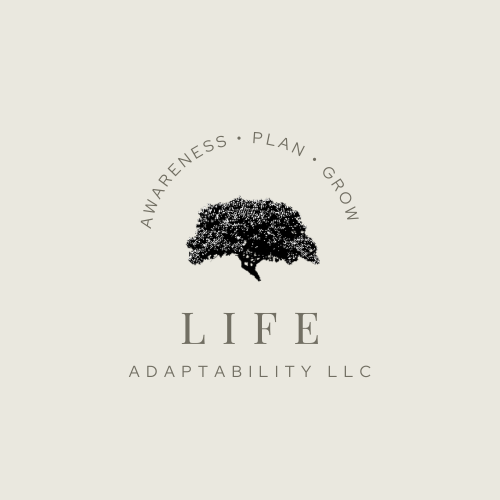Meeting Shayne, my guide dog
/What is a service dog and how do you interact?
By Deb Marinos MS, Certified Rehabilitation Counselor, Adaptability for Life LLC
I am a person with legal blindness with the honor and privilege to be guided by my trained service dogs in safety throughout the US. I have had 4 dogs and have used public transit, including airplanes, buses, and trains. I have had my dog at work, church, meetings, and many different public and private events.
So, now meet Shayne, my current dog. He is a black standard poodle, and was trained by Guide Dogs of the Desert to be very well behaved - which means he is not aggressive, and does not bark while in harness and working. Essentially, he does what he is told to do unless he senses that I am in danger when he will refuse to enter the roadway or drop off which is unsafe. He guides me by use of the handle on his leather harness. He does not need to wear a coat or bandana as his harness gives clear identification of his job.
The ADA and Oregon's laws require a service dog to do a job and be under my control, being well-behaved in order to be allowed anywhere the public is welcomed. Including all forms of transit, restaurants, meeting places, stores, and workplaces, regardless of a no-pet policy. Including motels. The discussions of allergies has been thoroughly debated and decided by the Department of Justice (DOJ) as NOT a valid reason to bar a service dog from public spaces. They make the point that other humans who own pets at home carry dander on their clothes, in larger quantities than a single, well-groomed service dog does. Regular, effective cleaning is sufficient to remove any allergens the dog (or pet owners) leaves behind. Shayne, as a poodle does not shed, is low dander, and is regularly groomed.
This does not mean he is perfect, and at times, he may bark once if suddenly surprised or wag his tail enthusiastic hoping you will pet him. Please do not pet or touch him at all. Instead, help him be a good dog by ignoring him. Do not make eye contact. Do not give him directions - instead, talk to me. Yes, he is my eyes to find my way, yet, I decide where to go. He listens to my commands and can be distracted, thus placing me in danger, by folks calling out to him. And for sure - please - no treats or food. He is on a veterinarian prescribe feeding regimen for both when and what. He can get sick with unfamiliar food and is trained to only eat out of his bowl or from me for his safety and wellbeing. If possible, ignore the dog, not me though!
By the way, it’s illegal for you to demand that I prove to you that he is a service animal. The law allows you to ask: “Is this dog a service animal and does he perform a job related to your disability?” No more.
You do have the right to ask any dog, even a service dog to leave YOUR premises - if the dog is loose wandering on its own, barking and/or growling aggressively at other people or pets after being told to stop by its owner or is showing lack of good house manners such as jumping or going potty indoors.
If you are in a store or other public space, you need to talk to the manager or representative if you feel threatened by the dog. The dog handler is not required to answer everybody that asks about the dog.
I believe the respect you show the well-behaved service dog by ignoring it and not touching the harness or dog is an extension of your respect for the person with a disability. Asking unnecessary questions about the dogs right to be in the place is at the least annoying and a waste of time and, at worse detrimental to that person's ability to function independently in the world as others do.
I appreciate your willingness to abide by the laws and allow the very visible white cane or dog harness to tell you the dog is a service animal. Thus, allowed wherever I go.
To read more frequently asked questions, search google for service animal rules or go to this link.
https://www.ada.gov/regs2010/service_animal_qa.html



